
A Guide to Faithfulness Groups
Reviewed by Patricia McBee
August 1, 2020
By Marcelle Martin. Inner Light Books, 2019. 109 pages. $25/hardcover; $12.50/paperback; $10/eBook.
If someone pays attention to the part of me that struggles to know God, my search intensifies. . . . If someone believes with me in the amazement of grace, prays with me, and reminds me of God’s tenderness, I live more thoroughly and bravely in sacred time.
That quotation from Friend Mary Rose O’Reilley appeared on the November 1994 cover of Friends Journal. I keep it on the wall above my desk, reminding me of the preciousness of the spiritual companions who help me to live more thoroughly and bravely in sacred time. Marcelle Martin has been one such companion for me.
In her helpful little book, Martin starts out by observing that “opportunities to speak openly about one’s faith are becoming increasingly rare in our society.” She cites a 2018 New York Times article that references a survey of 1,000 people, in which only 7 percent reported regular conversations about spiritual matters. The use of spiritual language in print has been declining for more than 100 years. She observes that “when there is only limited public conversation about the spiritual life, and when the vocabulary used to describe it declines in use, it becomes harder to be a social person and maintain a lively, growing faith.”
Martin reminds her readers:
Human beings are created with the capacity to be filled with divine love, to live in harmony with God’s will, and to be dedicated to contributing to the greatest good that is possible. . . . Faithfulness groups encourage their members to greater boldness in listening and responding to God’s call.
Over the years, I have participated in a variety of groups of this sort: spiritual friendship, mutual accountability groups, clearness committees, support committees, and mutual eldering. Participating with openhearted trust and genuine interest in others opens a world of possibility.
In a context of trust and safety, we can practice and learn to listen deeply. We can come to listen behind the words to the stirrings in the hearts of others in the group and thus become better able to listen to the stirrings in our own souls.
In the appendices to the book, we find testimonies from people who have participated in faithfulness groups and the blessings they have received.
The group is a vessel of the sacred in each gathered member and the group as a whole. That communion which holds Spirit—within, between, and beyond us—helps peer group members become more healthy and whole in service to a wounded world. . . . Coming together to share our stories of seeking to be faithful—sometimes succeeding and sometimes falling short of what we hope to be or do—we have intimate glimpses into our humanity and our holiness.
We read in another appendix of a group’s companionship with a member grieving the death of his wife:
“Are you sure you want to accompany me now . . . in my journey of grief, in the hardest time of my life?” he asked. “Yes,” they said, “we want to accompany you even through death, through grief and in the hardest time of your life.” So we gathered for three days of silence, worship, meals, walks, and conversation, in tears and laughter and the whole symphony of emotions. Thanks be to them, thanks be to the Love that is in them, for Love is of God.
A Guide to Faithfulness Groups describes a methodology for groups who gather on some regular basis, perhaps monthly, to explore their experience of the Spirit. I find Martin’s guidelines to be sound and useful. Her clear instructions should be helpful to any group seeking to experiment with supporting one another in learning to listen for and act on the guidance of the Spirit.
The instructions are fairly specific, and may to some readers seem to be too confining; however, I recommend following them closely when a group first forms. The recommended disciplines help to break usual social patterns that distract from deep listening and from attention to the subtle movements of the Spirit. Over time, it may come to feel more natural. Or, after a period of meeting together under these guidelines, the group might consider whether any modifications might help to better reach its desired goals.
For those who like the idea of such a group but not the specific structure, the first appendix gives brief descriptions of “other kinds of sacred and healing circles” with similar goals but different structures and foci.
Dear friends, I invite you to enter into the joy of a circle of companions on the spiritual journey. Take up this lovely book that provides a path to deepening your search together. I wish you the blessing of living with greater clarity and living “more thoroughly and bravely in sacred time.”
Patricia McBee, now a member of Newtown (Pa.) Meeting, was for more than four decades a member of Central Philadelphia (Pa.) Meeting. She has written and traveled among Friends with a concern for Quaker spirituality, Quaker process, and a loving concern for the care of our planet.


